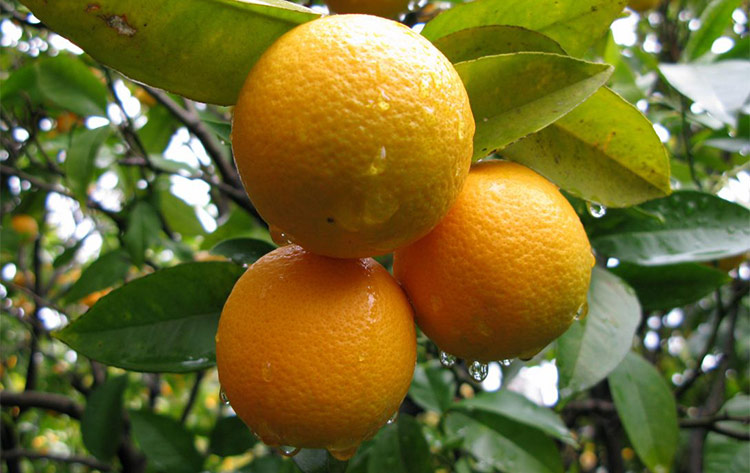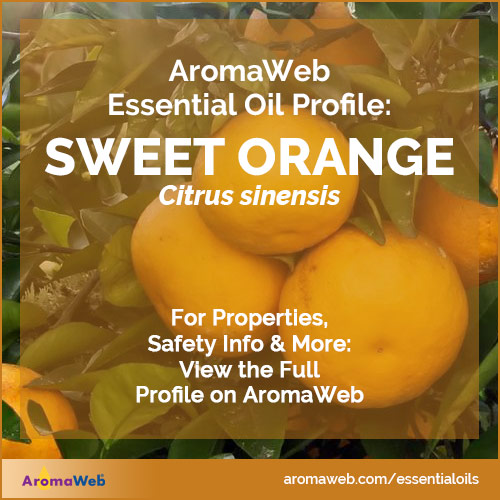Sweet Orange Essential Oil
Citrus sinensis

Description
Sweet Orange Essential Oil is most often referred to simply as Orange Oil.
With its versatility, affordability and wonderfully uplifting aroma, Sweet Orange Essential Oil is one of the most popular of essential oils within aromatherapy. The aroma of Sweet Orange Oil is cheerful and helps to improve the aroma of a stale-smelling or smoky room. (Lemon Essential Oil is even better for diffusing in smoky rooms). Sweet Orange Essential Oil has become a popular ingredient within a wide assortment of natural (and some not-so-natural) household cleaning products.
Some people can't tolerate citrus essential oils (or are even allergic), so be prudent when diffusing Sweet Orange Essential Oil around others, but overall, Sweet Orange Essential Oil is a winner with children and adults alike.
Unlike most essential oils that are extracted using steam distillation, most citrus oils including Sweet Orange Oil are extracted by cold pressing the rinds of the orange. You will sometimes find a steam distilled variety on the market, but it is fairly uncommon.
When you have peeled an orange, have you ever noticed tiny droplets spray from the peel (not the fruit segments) and noticed a burst of orange aroma at the same time? What you noticing is the essential oil that lives in the rind escaping as you peel the fruit. The next time that you peel an orange (or other citrus fruit), try pressing a portion of the rind between your fingers, and you should be able to smell the intense aroma of the essential oil escaping from the rind.
Sweet Orange Essential Oil Benefits and Uses
- Colds
- Constipation
- Dull Skin
- Flatulence
- Flu
- Gums
- Mouth
- Slow Digestion
- Stress
Source: Julia Lawless, The Encyclopedia of Essential Oils (Updated Edition) (London: Harper Thorsons, 2014), 153-154.
Botanical Name
Plant Family
Common Method of Extraction
Cold Pressed/Expressed
Plant Part Typically Used
Color

Pale Yellow to Orange
Consistency
Thin
Perfumery Note
Top
Strength of Initial Aroma
Medium - Strong
Aromatic Description
Sweet Orange Essential Oil smells citrusy and sweet. Its aroma is similar to that of orange peels, but it typically smells sweeter and is more concentrated.
Major Constituents of American Sweet Orange Oil
- (+)-Limonine
- B-Myrcene
- a-Pinene
See Essential Oil Safety for more complete list of typical constituents.
[B.M. Lawrence, Essential Oils 1988-1991 (Wheaton: Allured Publishing, 1995), 48-49. Source cited in Robert Tisserand and Rodney Young, Essential Oil Safety (Second Edition. United Kingdom: Churchill Livingstone Elsevier, 2014), 372.]
Sweet Orange Essential Oil Safety Information
Tisserand and Young do not indicate any special precautions when using Sweet Orange Essential Oil. However, they precaution to avoid use of the oil if it has oxidized. Reading Tisserand and Young's full profile is recommended. [Robert Tisserand and Rodney Young, Essential Oil Safety (Second Edition. United Kingdom: Churchill Livingstone Elsevier, 2014), 372.]
I have read conflicting reports as to whether Sweet Orange Essential Oil is phototoxic. However, essential oil safety experts Robert Tisserand and Rodney Young do not indicate that it's phototoxic. Do pay close attention to the type of orange oil you are using as Bitter Orange Essential Oil is phototoxic.
General Safety Information
Do not take any oils internally and do not apply undiluted essential oils, absolutes, CO2s or other concentrated essences onto the skin without advanced essential oil knowledge or consultation from a qualified aromatherapy practitioner. For general dilution information, read AromaWeb's Guide to Diluting Essential Oils. If you are pregnant, epileptic, have liver damage, have cancer, or have any other medical problem, use oils only under the proper guidance of a qualified aromatherapy practitioner. Use extreme caution when using oils with children and be sure to first read the recommended dilution ratios for children. Consult a qualified aromatherapy practitioner before using oils with children, the elderly, if you have medical issues or are taking medications. Before using this or any essential oil, carefully read AromaWeb's Essential Oil Safety Information page. For in-depth information on oil safety issues, read Essential Oil Safety by Robert Tisserand and Rodney Young.
Shelf Life
Important Information About the Profiles
The essential oil information provided on AromaWeb is intended for basic educational purposes only. The references to safety information, test results, constituents and percentages is generalized information. Essential oils can vary greatly in composition. The data is not necessary complete and is not guaranteed to be accurate. The essential oil photos are intended to represent the typical and approximate color of each essential oil. However, essential oil composition and color can vary based on harvesting, distillation, age of the essential oil and other factors. Profiles for several CO2 Extracts and absolutes are included within the directory, and are denoted as such.
